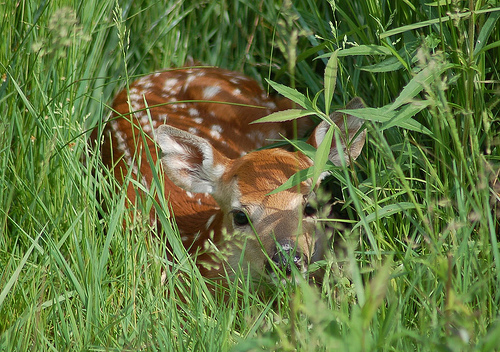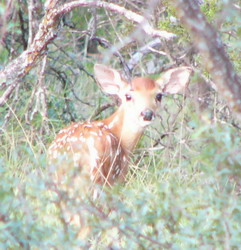Good habitat is important for a healthy white-tailed deer population and necessary for successful deer management. Not only does high quality habitat provide nutritious food and great cover, but good deer habitat also provides a good amount of grass, especially during the fawning season. Deer do not consume very much grass at all–it usually comprises less than 8% of their diet on an annual basis–but tall grass is very beneficial to fawns.
For white-tailed deer, fawns are typically dropped about 7 months after conception. Because the gestation period averages about 205 days in whitetail, the major fawning period is roughly 7 months after the peak of rut. Does bred early in the rut will fawn earlier and those bred late will fawn later, but the majority of deer fawns in a given area will hit the ground at approximately the same time, usually during about a two week period. Fawns, however, don’t usually get a lot of attention from hunters. And there are probably a few reasons.

First, fawning takes place during the late spring and early summer. Many hunters are still “checked-out” at this time of year only to return in late summer or early fall to plant a hunting plot or fill their deer feeders. Secondly, we are talking about fawns here, not big, gigantic, muy grande bucks! Hunters hunt bucks, not fawns. With that said, land owners interested in deer management realize that mature bucks do not just appear out of thin air.
So let’s talk about fawns. The early life of a fawn and the life of an adult whitetail are quite different. For the most part, adult deer do not require a whole lot of grass. The only grass they use in their diet is young and tender. Fawns, on the other hand, need grass and do not even know it. First of all, moderate to high grass makes excellent fawning cover. Not only does this herbaceous cover help conceal newborn fawns, but tall grass is indicative of good white-tailed deer habitat, which is needed by nursing does to raise healthy fawns.
In addition, good fawning cover decreases the impact predators can have on a yearly fawn crop. Research has shown that high quality deer habitat can produce good fawns crops even with dense predator populations. However, even on properties where predators are controlled, if the habitat is poor then fawn crops are not necessarily good. This does not make sense to some people, but it’s true.
First, poor habitat can be caused by many things, but over-grazing by livestock is the number one reason for low-quality habitat. A lack of ground cover makes it really easy for predators (even if few) to find newborn fawns. In addition, generally poor habitat means does will have difficulty finding adequate nutrition to produce milk and raise fawns. You see, over-grazing by cattle leads first to an over-use of grass and then to an over-use of browse species. Over-grazing by goats first leads to an over-use of browse species and then to an over-use of grass species. In either situation, it leads to poor deer habitat and poor fawn crops. Properties that lack at least some open, grass-dominated areas also provide poor deer habitat overall.
Any practice that removes ground cover during the fawning season should be discouraged if you want to improve the fawn crop in your area. The mowing or haying of fields should be postponed at least one month before fawns drop until after the bulk of the fawns have been born, which is usually around the end of June. However, you can figure this out for your area by adding 8 months to the time when the peak of the rut occurs.
Additionally, keep an eye on your predator population and do what you can to control them, but especially in areas with less than ideal fawning habitat. There is quite a bit of time between now and deer season, but the deer you should be thinking about is the one you will be harvesting about 5 1/2 years from now.

